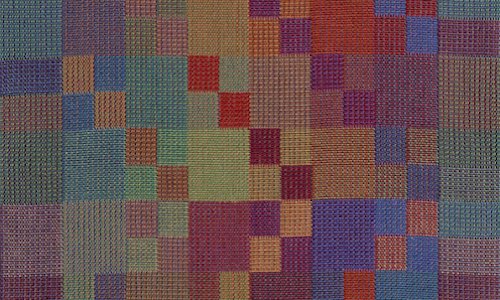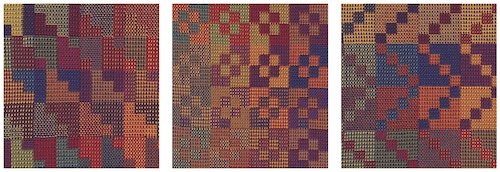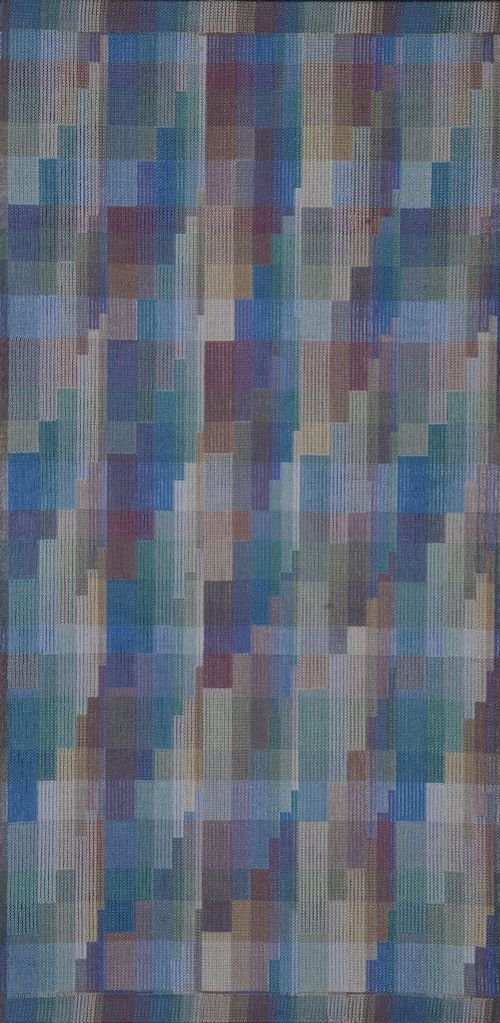Double Rainbow Evolves, part 2
As I experimented with weaving in the Double Rainbow system in two blocks on 8 shafts and seeing how the combinatory possibilities for color and pattern were truly endless, I realized that I needed to find a system for encoding and notating information. Otherwise it would be like falling down a rabbit hole and never being able to find your way out again.
This problem had me stymied for quite some time and I spent many hours with my head in my hands trying to figure out a way to organize the information into a tidy and understandable form. I gradually worked out graphic symbols to represent the blocks and layers and came up with a tie-up matrix. I won’t go into it here, but all of the information is in the revised edition of my Doubleweave book and in the workshops that I teach.
What is particularly exciting about this to me is that once you have the templates for the 2-block tie-ups you have everything you need to apply them to as many blocks as you are able to create on the loom that you have. Since I have a 32-shaft compudobby loom I have the capability to weave eight blocks of doubleweave in a plain weave structure.
Next I put a 4-block warp on 16 of my shafts in a six color rotation and just played around with weaving the four treadling blocks in various combinations. Here are just three designs that I wove on that warp, changing the order of the treadling blocks in various ways.
I could easily have put on a mile of that warp and kept going and going, continuously coming up with new designs. But I wanted to start creating intentional overall designs that could be finished pieces in their own right.
At the same conference that I had bought Rosalie Nelson’s Exaltation of Blocks set I was also seduced in the Lone Star Loom Room booth by the array of beautifully colored cones of Venne 20/2 cotton. My intention was to pick out six colors to weave in the Double Rainbow system, but they offered a special of a free cone for every four cones that you bought, so I ended up getting ten cones for the price of eight, or maybe it was fifteen cones for the price of twelve, I’m not sure. At any rate, I have gradually added on to my stash and now have about three dozen colors in the Venne cotton.
I worked out a rotation of seven of the Venne colors that I liked and drew a design on graph paper using seven threading blocks of doubleweave on 28 shafts. By using the tie-up templates that I had developed I was able to plug those into my Fiberworks software for all the different areas of design. I set the Venne cotton at 32 ends per inch for each layer for a total of 64 ends per inch, sleyed 8 per dent in an 8-dent reed.
I started out by weaving a small piece that I call Game Board for a Diverse World that I stitched a few little beads onto here and there, mounted onto a fabric backing and framed -
Next I drew a more complex design onto graph paper that takes advantage of the number of blocks and plays with arranging them in different symmetry patterns. This piece is called Parquet Permutations I, which was inspired by an article in Scientific American exploring a concept known as Parquet Deformations. I added the designation ‘I’ to the title because I think there may be more pieces in this series yet to come -
Parquet Permutations I
Just recently I set up a warp for another pair of pieces, using a rotation of eight colors and seven blocks of doubleweave on 28 shafts, but this time in more muted, smoky colors. As I looked at the range of colors together it made me think about about changes in the sky that we get during the summer monsoon season in New Mexico.
Typically days start out very clear and sunny, with hardly a cloud to be seen in the sky. By mid-afternoon clouds start rolling in and become increasingly darker as the afternoon progresses. On some days you start to hear an ominous, rumbling thunder - something that makes dogs, and probably other animals quite nervous. And then, if we’re lucky, we get a dramatic downpour of rain that passes fairly quickly and leaves the air and the plants washed clean. To me, the smell of sagebrush in the air after a rainstorm evokes the magic of the desert southwest.
Rolling Thunder
Walking Rain






